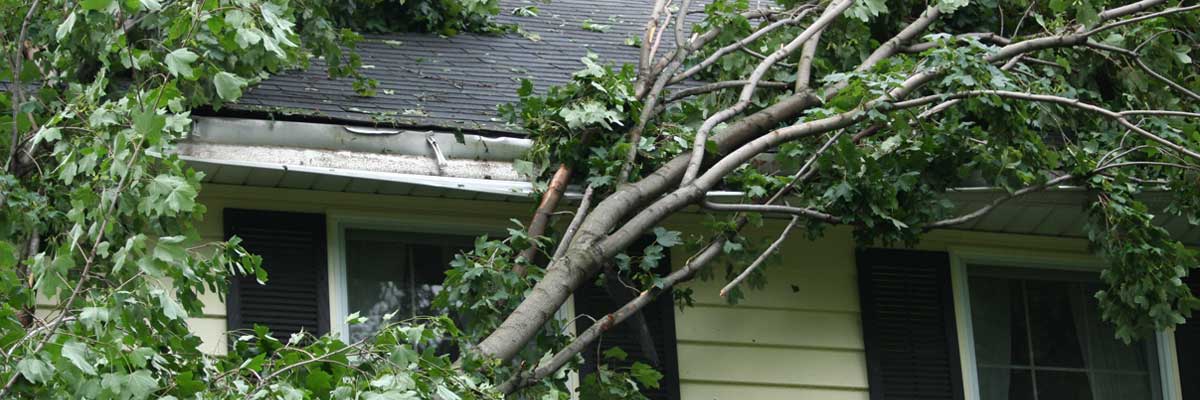
5 things to know about fallen trees and insurance coverage

It’s the time of year when the temperatures warm and the flowers bloom, putting us all in a chipper mood. But, it’s also time for thunderstorms, which most often occur in the spring and summer months, according to the National Severe Storms Laboratory.
With spring officially arriving this Friday, March 20, it’s the ideal time to review what your homeowners insurance, and even your car insurance, may or may not cover when it comes to damage from fallen trees.
Here are five important things to keep in mind:
1. Your homeowners insurance likely covers tree removal and damage repairs for your home and other insured structures, such as fences.
A tree falls on your property and damages one or more insured structures. What now? Your homeowners insurance will likely help with the cost of removing the tree and repairing the damage. That’s once you pay your deductible, of course. Examples of covered incidents can include strong winds knocking a tree over onto your roof or lightning striking a tree, causing it to fall on your fence.
However, if a tree falls due to neglect, you may not receive any coverage. So keep your trees in good shape, and ask your neighbors to do the same.
2. If there’s no damage, there’s likely no insurance coverage.
You may assume your homeowners insurance will cover the removal costs of any fallen tree, but that isn’t always the case. If a tree falls on your property without damaging any insured structures, you will likely need to cover the costs of tree removal yourself.
3. Your city or municipality may clean up trees that fall into the street, but you may still have reason to file an insurance claim.
Check with your city or municipality to determine who’s responsible for removing a tree that falls into the street. If your city takes responsibility, it may only be for the portion that’s in the street. Any of the felled tree that’s left on your property will be your responsibility. Your insurance may help if an insured structure was damaged in the incident.
4. You may have coverage even if a tree falls from your neighbor’s property.
When a fallen tree damages your property, your homeowners insurance may pitch in no matter who owned the tree. Depending on the circumstances, your insurance carrier may attempt to recoup some of the costs, including your deductible, from your neighbor’s insurance. This may occur, for example, if the neighbor was negligent in caring for the tree before it fell.
5. Your car insurance may cover damage to your vehicle from a fallen tree.
If a tree falls from your property onto your car, it’s your car insurance and not your homeowners insurance that will likely help cover the cost of repairs. But, the tree doesn’t have to be from your property. You likely have coverage if a tree falls on your car, no matter from where. What may not be covered? The cost to remove the tree from atop your car.
Of course, every insurance carrier handles fallen trees differently. It all depends on the specifics of your policy and your coverage limits, as well as the specifics of your situation. If you need to file an insurance claim for a fallen tree, use the tips below.
Tips for Filing an Insurance Claim for a Fallen Tree
Take photos: Photos taken from many angles and vantage points help to establish the extent and cause of the damage. Be careful not to go near fallen trees that are entangled in power lines, however. And don’t climb onto an unstable surface to get better photos.
Provide as many details as possible: If, for example, a neighbor’s tree was neglected and fell onto your property, causing damage, be sure to tell your carrier. If a storm caused the tree to fall, be sure to provide details about the severity of the weather.
Be prepared to pay your deductible: If you experience a covered loss due to a fallen tree, you will be responsible for paying the appropriate deductible.
Your homeowners insurance, or car insurance, covers damage from a fallen tree in many instances. But, it’s important to know when you’re covered and when you’re not. So review your policy with your local insurance agent and ask plenty of questions about when a fallen tree is covered by your insurance and when it isn’t.
Time for Your Annual Insurance Review?
An annual insurance review helps ensure your policies are up to date with the coverage you need today. Contact us today at (425)212-3505 for a review of your insurance coverages.
Source: Safeco Insurance
Categories: Blog
